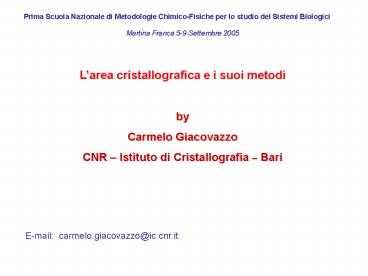Diapositiva 1 - PowerPoint PPT Presentation
1 / 39
Title:
Diapositiva 1
Description:
When neutrons or X-Rays are used diffraction intensities are collected ... X-Ray Laue photograph of an. icosahedral Al-Mn-Pd quasicrystal. with fivefold symmetry ... – PowerPoint PPT presentation
Number of Views:30
Avg rating:3.0/5.0
Title: Diapositiva 1
1
Prima Scuola Nazionale di Metodologie
Chimico-Fisiche per lo studio dei Sistemi
Biologici Martina Franca 5-9 Settembre 2005
Larea cristallografica e i suoi metodi
by Carmelo Giacovazzo CNR Istituto di
Cristallografia Bari
E-mail carmelo.giacovazzo_at_ic.cnr.it
2
About Crystallography
- Crystallography is usually associated to ordered
systems ( crystals ). - Crystals are nothing else but the
three-dimensional repetition of a motive (the
content of the the unit cell) - The tool of the crystallographic investigation is
the diffraction.
3
When neutrons or X-Rays are used diffraction
intensities are collected When electron radiation
is used the phase is not lost
4
The phase is lost
The phase is not lost
5
- Atomic scattering factors for
- Electrons( they see the electric field)
- X-Rays ( they see the electrons)
- Neutrons ( they see the nuclei)
6
MODERN CRYSTALLOGRAPHY The application
field from ordered systems (crystals)
to polymers, fibres, etc
to amorphous materials (solid, liquid, gas)
7
CRYSTAL STRUCTURE SOLUTION
- In the practice
- where
- and
- It depends on the interatomic coordinates
8
About the basic tools
- The information one can use to solve a crystal
structure is - A) the positivity of the electron density
- B) the atomicity
- The phase problem is practically solved for
structures up to 200 atoms in the asymmetric
unit. - The phase problem is still open for the proteins
9
About the experimental information
- The experimental information is contained in the
data. - As a rule of thumb, data up to 1Å resolution are
full informative. - For proteins this resolution is only seldom
attained . Therefore supplementary data are
necessary , which are provided by the following
techniques - A) isomorphous derivatives
- B) anomalous dispersion
- C) molecular replacement
10
(No Transcript)
11
(No Transcript)
12
Diffuse
scattering
-
It is due to - Inelastic scattering generated by electronic
excitations - thermal diffuse scattering related to atomic
motion (TDS) - scattering from disorder and/or from crystal
defects (DDS)
13
Experimental and calculated difraction pattern
from tRNA crystals
14
Experimental and calculated diffraction patterns
from crystals of Calmodulin
15
Modulated crystal
structures
- They are perfect crystals with periodic
distorsion from some basic structure. - The modulated atomic parameters may be one or
several of the following - Coordinates (displacive modulation)
- b) Occupancy factors on displacement parameters
(density modulation) - c) Orientation of the magnetic moments ( magnetic
structure) - d) Two or more intergrown periodic structures
with mutually incommensurated lattices (
composite structures).
16
Experimental evidence satellite
reflections, main reflections
One-dimensional modulated structure Sketch of a
section of the three-dimensional Diffraction
pattern, showing main and satellite reflections
From S4 to S3. Main and satellite reflections
are denoted by M and W respectively
17
Quasicrystals
Diffraction pattern of a decagonal Al-Co-Ni
quasicrystal. Computer reconstruction of the
second layer from 720 images
18
X-Ray Laue photograph of an icosahedral Al-Mn-Pd
quasicrystal with fivefold symmetry
19
The mathematical basis
of quasi crystals
1) f(x1,x2) A1sin2?x1 A2sin2?x2
Let us assume x2 ?x1 where ? is an irrational
number, then
f(x1) A1sin2?x1 A2sin2??x1
is not periodic.
20
where
is the golden mean. Since a and a?/2 are
incommensurate numbers the structure is not
periodic.
21
The aperiodic long-range ordered structure and
its periodic approximants
22
Powder diffraction If single crystals
of sufficient size are not available ,
then Powders may be used for diffraction. Three-d
imensional data Collapse in a one-dimensional
Pattern. Intensities overlap. X-Ray and
neutron radiations are frequently used.
23
Via powder diffraction data
- Crystallinity degree
- Qualitative analysis
- Quantitative analysis
- Residual stress
24
Liquid crystals
They constitute an intermediate state between
liquid and crystals
- uniaxial nematic system made up by
- rod-like molecules
- b) its typical diffraction pattern
25
Typical cholesteric mesophase organisation
26
- Arrangements of a simple
- lipid-water system
- lamellar L
- rectangular P
27
Fiber diffraction
28
CRYSTALLOGRAPHY
AND LIQUIDS The distribution function P(u) for a
linear arrangement of objects of length a and of
increasing compactness, according to Zernicke
Prins. The ratio between a and the length l
varies from 0.5 to 0.90.
29
(No Transcript)
30
(No Transcript)
31
Liquid Mercury Distribution p(u)
32
Liquid nitrogen at 89K. Average number of atoms
at a distance x for a given atom.
33
Crystallography and Material Science Defects in
crystal may be studied the kinematic
approximation in no more sufficient. Dynamical
theory of diffraction is necessary
X-Ray section topograph of a dislocations in
silicon
34
X-Ray topograph of quartz showing A great number
of dislocations
35
Crystal structure determination via HREM and
Crystallographic Image Processing
- The crystal structure may be determined by back
Fourier transforming the image and/or by using
electron diffraction data - STEPS
- Crystal Symmetry
- Elimination of the noise due to lattice
averaging - Correction for defocusing and astigmatism
- Compensation for the crystal tilt
- 3D crystal structure determination
36
Data perturbation
- Dynamical scattering
- Secondary scattering
- Crystal bending (causing incoherence of the
diffracted beam) - Radiation damage
37
Electron diffraction Pattern from Gas . Working
temperature about 353 K
38
Gas electron diffraction for C6H5-NO2 gas
Molecular intensity curves E, experimental T,
theoretical Two camera distances
39
Radial distribution curves For C6H5-NO2 E,
experimental T, theoretical































